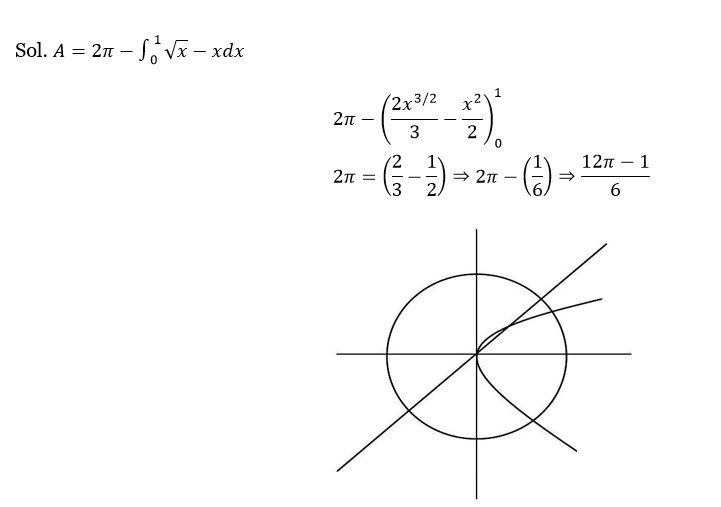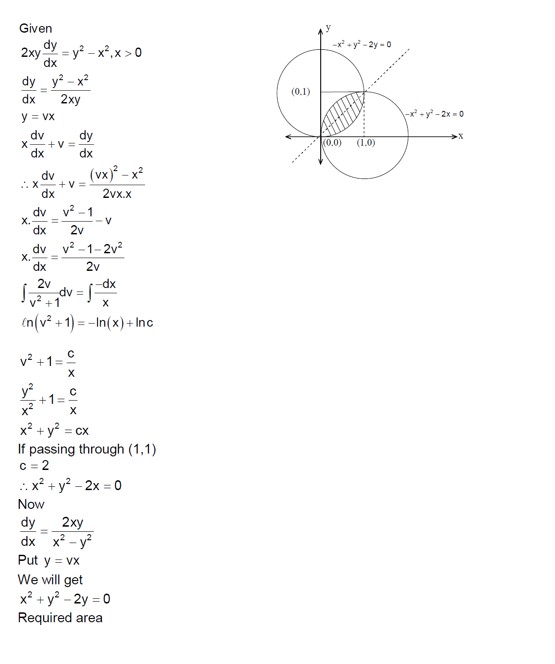Differential Equations
Get insights from 323 questions on Differential Equations, answered by students, alumni, and experts. You may also ask and answer any question you like about Differential Equations
Follow Ask QuestionQuestions
Discussions
Active Users
Followers
New answer posted
2 months agoContributor-Level 10
e? dy = e? /α dx
⇒−e? =e? /α+c
y (ln2)=ln2 and y (0)=−ln2
⇒−2=−1/α+c
⇒c=−2−1/α
⇒e? = 1/α e? −2−1/α
⇒−e? ² = 1/α e? ²−2−1/α
⇒2? ¹=3/α
⇒α=2
New answer posted
2 months agoContributor-Level 10
dy/dx + (2? (2? -1)/ (2? ¹ (2? -1) = 0
x, y > 0, y (1) = 1
dy/dx = – (2? (2? -1)/ (2? (2? -1)
∫ (2? -1)/2? dy = –∫ (2? -1)/2? dx
log? (2? -1)/log?2 = – log? (2? -1)/log?2 + log? c/log?2
Taking log of base 2.
∴ y = 2 – log?3
New answer posted
2 months agoContributor-Level 10
I = ∫ (e? (x²+1)/ (x+1)² dx = f (x)e? + c
I = ∫ (e? (x²-1+1+1)/ (x+1)² dx
I = ∫e? [ (x-1)/ (x+1) + 2/ (x+1)² ] dx
for x = 1
f' (1) = 12/24 - 12/16 = 3/4
New answer posted
2 months agoContributor-Level 10
Given kx^ (k-1) + k * y^ (k-1) * dy/dx = 0.
dy/dx = - (kx^ (k-1) / (ky^ (k-1) = - (x/y)^ (k-1).
The provided solution has dy/dx + (x/y)^ (k-1) = 0.
It seems to relate to k-1 = -1/3, which implies k = 1 - 1/3 = 2/3.
New answer posted
2 months agoContributor-Level 9
dy/dx + 2y tan (x) = sin (x)
I.F. = e^ (∫2tan (x)dx) = e^ (2ln (sec (x) = sec² (x)
Solution is y sec² (x) = ∫sin (x)sec² (x)dx = ∫sec (x)tan (x)dx
⇒ y sec² (x) = sec (x) + c
y (π/3) = 0 ⇒ 0 * sec² (π/3) = sec (π/3) + c ⇒ 0 = 2 + c ⇒ c = -2.
∴ y = (sec (x) - 2) / sec² (x)
Now let g (t) = (t - 2)/t² = 1/t - 2/t² for |t| ≥ 1.
g' (t) = -1/t² + 4/t³
g' (t) = 0 ⇒ t = 4.
g' (t) = 2/t³ - 12/t? g' (4) < 0, hence maximum.
∴ g (t)max = g (4) = (4 - 2)/4² = 2/16 = 1/8.
New answer posted
2 months agoContributor-Level 10
dy/dx + (tanx)y = sinx. This is a linear differential equation.
Integrating Factor (I.F.) = e^ (∫tanx dx) = e^ (ln|secx|) = secx.
The solution is y * I.F. = ∫ (sinx * I.F.) dx + C.
y * secx = ∫ (sinx * secx) dx = ∫tanx dx = ln|secx| + C.
Given y (0) = 0.
0 * sec (0) = ln|sec (0)| + C => 0 = ln (1) + C => C = 0.
So, y * secx = ln (secx).
y = cosx * ln (secx).
At x = π/4:
y = cos (π/4) * ln (sec (π/4) = (1/√2) * ln (√2) = (1/√2) * (1/2)ln (2) = ln (2) / (2√2).
New question posted
2 months agoTaking an Exam? Selecting a College?
Get authentic answers from experts, students and alumni that you won't find anywhere else
Sign Up on ShikshaOn Shiksha, get access to
- 65k Colleges
- 1.2k Exams
- 679k Reviews
- 1800k Answers



